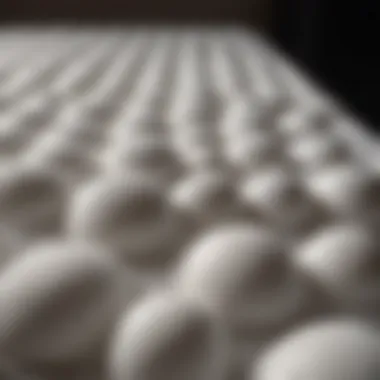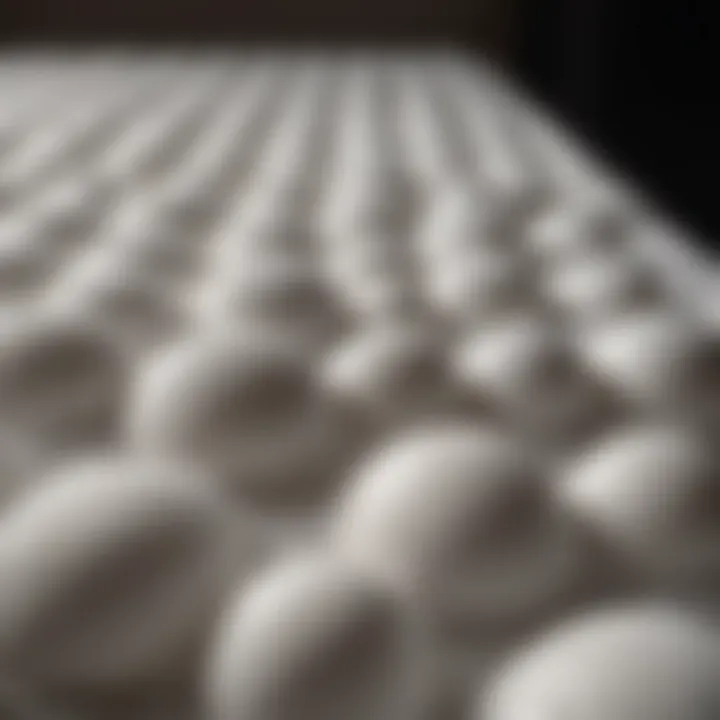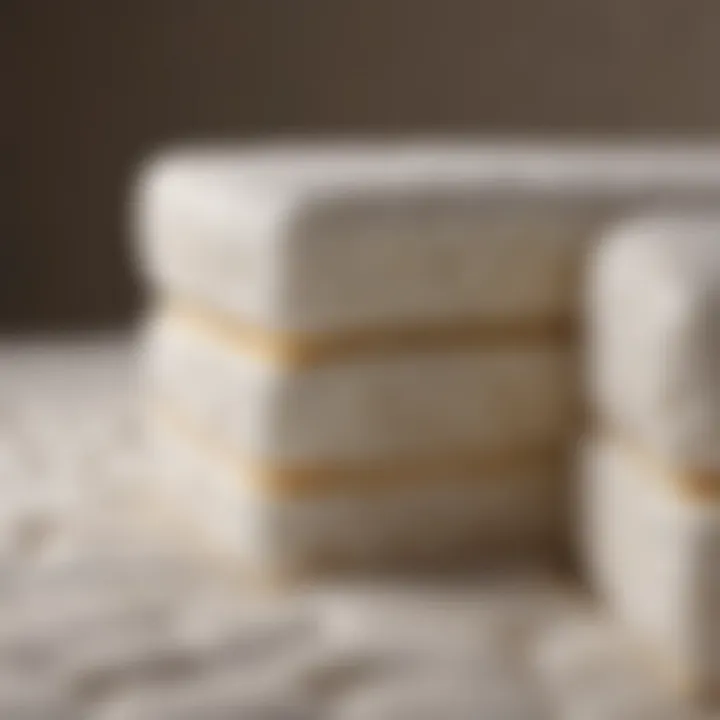Exploring Sleep Science and Foam Mattress Benefits


Summary of Objectives
This article delves into the intricate relationship between sleep science and foam mattress technology. It intends to elucidate the physiological principles that impact sleep quality, and how foam mattresses are specifically designed to enhance these principles. The discussion covers various types of foam, their densities, and how they relate to sleep posture, which is crucial for overall health.
Importance of the Research
Understanding how sleep and mattress technology intersect is vital for making informed choices about sleep environments. The findings presented here support the hypothesis that selecting the right foam mattress can significantly influence sleep quality and health outcomes.
Preface
In today’s fast-paced world, where quality sleep often takes a backseat, understanding the science behind sleep and the technology of foam mattresses becomes increasingly essential. Sleep is not merely a state of rest but a complex physiological process that impacts multiple facets of human health.
Various factors contribute to effective sleep, including environment, posture, and mattress design. Foam mattresses, in particular, have garnered attention due to their unique properties tailored to provide comfort and support during sleep.
This article aims to explore the critical components of sleep science and how foam mattresses can enhance this experience. We will outline the types of foam, the significance of foam densities, and the ways in which sleep posture affects health. By addressing common misconceptions and providing insights into optimal sleep environments, we aim to empower readers to make informed choices regarding their sleep needs.
Results and Discussion
Presentation of Findings
Research indicates that certain foams, such as memory foam and latex, possess unique characteristics conducive to better sleep. These materials adapt to the body's contours, providing support while relieving pressure points. Different foam densities contribute to varying levels of firmness and comfort, which can cater to individual preferences and needs.
For example, higher-density foams typically offer greater support and durability, whereas lower-density foams may provide a softer feel. Understanding these variables is crucial for selecting a mattress that aligns with personal sleep habits.
Implications of Results
The implications of these findings are profound. The right foam mattress not only enhances comfort but also plays a role in reducing sleep disturbances related to posture and support issues. Inadequate sleep can lead to a range of health problems, including chronic pain and cognitive dysfunction. Therefore, the choice of mattress is not just a matter of comfort but of health and well-being.
Important Note:
Selecting an appropriate foam mattress can significantly improve sleep quality and may contribute to healthier sleep patterns.
To summarize, this exploration of sleep science and foam mattresses reveals the importance of considering both the physiological aspects of sleep and the technological advancements in mattress design. Individuals are encouraged to evaluate their sleep needs critically and make choices that promote restorative sleep.
Preamble to Sleep Science
Sleep is a vital physiological process that significantly affects our overall well-being. This article focuses on the scientific aspects of sleep and how they relate to foam mattresses. By understanding sleep science, one can better appreciate the role of mattress technology in enhancing sleep quality. Key elements include the various stages of sleep, the importance of sleep cycles, and how different mattress types can support these stages.
Definition of Sleep Science
Sleep science examines the mechanisms of sleep, its stages, and how it influences physical and mental health. This field integrates elements of biology, psychology, and neuroscience. Researchers study factors such as sleep disorders, circadian rhythms, and the effects of sleep deprivation. The main goal is to understand the function of sleep and provide solutions for better sleep management.
Historical Perspectives on Sleep Study
The study of sleep has evolved over the centuries. Early views were often mystical or philosophical. In modern times, sleep research became rigorous and data-driven. The development of polysomnography, a method of recording brain activity during sleep, revolutionized the understanding of sleep stages. This historical context helps clarify the advancements made in understanding how sleep interacts with various factors, including environment and physiological states.
The Importance of Sleep for Health
Quality sleep is essential for physical recovery, cognitive function, and emotional regulation. Research shows that inadequate sleep contributes to numerous health issues such as obesity, diabetes, and cardiovascular problems.
- Important benefits of adequate sleep include:
- Improved memory consolidation
- Enhanced mood stability
- Better immune function
Sleep serves to restore the body and allows for necessary mental repairs. Inadequate sleep does not just affect the individual but can also have wider societal impacts, such as increased healthcare costs and reduced productivity. Thus, understanding sleep science is crucial, especially as it relates to choosing the appropriate sleep surfaces like foam mattresses.
"Sleep is not just a passive state; it is an active process crucial to our health."
In the following sections, we will explore how foam mattresses are engineered to enhance sleep, aligning with the physiological requirements identified in this field.
Foundations of Sleep Mechanics
Foundations of sleep mechanics are crucial to understanding how foam mattresses interact with various aspects of sleep. Sleep itself is a complex biological process governed by multiple factors. This section aims to illuminate the essential elements of sleep cycles and biological rhythms, emphasizing their relevance to foam mattress design and user experience.
By grasping these foundational concepts, one can better appreciate how sleep quality is achieved and maintained, and subsequently how foam mattresses can be optimized to enhance this experience.
Sleep Cycles Explained
REM Sleep


Rapid Eye Movement (REM) sleep is a unique phase characterized by heightened brain activity and vivid dreaming. During this phase, the brain engages in memory consolidation and emotional processing. The key characteristic of REM sleep is its cyclical nature, which typically occurs several times throughout the night, with longer durations toward the morning. This phase is beneficial, as it contributes to cognitive functions and mood regulation.
One notable feature of REM sleep is the temporary paralysis of major voluntary muscle groups, which serves as a protective mechanism. However, the advantages of REM sleep come with some risks, as disrupted REM, often linked to inadequate sleep environments, can undermine overall sleep quality and result in cognitive deficits.
NREM Sleep
Non-Rapid Eye Movement (NREM) sleep encompasses several stages that significantly impact restorative functions. The most notable aspect of NREM sleep is its division into three stages associated with varying depths of sleep. These stages progress from light to deep sleep, making NREM critical for physical recovery, immune function, and hormonal regulation.
The key benefit of NREM sleep is its role in bodily repair, where growth hormone levels surge, promoting muscle tissue repair and cell regeneration. An interesting feature of NREM sleep is its ability to promote the lowest metabolic rates of the night. However, disruptions during NREM can lead to feelings of grogginess upon waking, affecting alertness throughout the day.
Stages of Sleep
The stages of sleep refer to the overall progression from light sleep through NREM and into REM. Each cycle typically lasts about 90 minutes and repeats number of times during a night. The ability to transition smoothly through these stages is crucial for maintaining overall health. The key characteristic of sleep stages is the alternating pattern between NREM and REM, allowing both physical and mental rejuvenation.
An important feature of sleep stages is that different factors, including mattress quality, can influence the efficiency of these transitions. If a mattress fails to provide adequate support or comfort, it may hinder movement through sleep stages, thereby lowering sleep quality.
Biological Rhythms and Sleep Patterns
Circadian Rhythms
Circadian rhythms are natural, internal processes that regulate the sleep-wake cycle, recurring roughly every 24 hours. The key aspect of circadian rhythms is their synchronization with the light-dark cycle, which plays a crucial role in determining sleep timing and duration. By facilitating the production of melatonin during periods of darkness, circadian rhythms influence when we feel sleepy or alert.
One unique feature is that circadian rhythms impact not only sleep but also various bodily functions like hormone release and digestion. However, factors such as irregular sleep patterns can disrupt these rhythms, leading to sleep disorders that foam mattresses alone cannot resolve.
Sleep Regulation Mechanisms
Sleep regulation mechanisms encompass the biological processes that maintain sleep homeostasis, balancing sleep drive and wakefulness. The key characteristic lies in the interplay between homeostatic sleep drive and circadian signals. This balance determines optimal sleeping patterns, which is crucial for sustained wakefulness and alertness.
A unique aspect of these mechanisms is their involvement in sleep debt accumulation. Prolonged sleep deprivation leads to increased sleep drive, affecting overall health. Understanding these processes can inform decisions on mattress selection that support healthy sleep.
Influences of Light on Sleep
The influences of light on sleep primarily revolve around its ability to disrupt melatonin production. Exposure to bright light, particularly blue light from screens, can hinder the natural sleep-wake cycle. The key aspect of this influence is that light exposure in the evening can delay sleep onset and diminish sleep quality.
Unique features of light's effect include its capacity to affect mood and cognitive function through biological pathways. While light exposure during the day aids alertness, overexposure at night can severely impact restorative sleep, making it imperative to create a sleep-conducive environment aided by suitable mattress options.
Foam Mattress Composition
Foam mattress composition is crucial to understanding how these mattresses contribute to sleep quality. Different materials and manufacturing processes affect comfort, support, and durability. Identifying the right composition helps consumers select a mattress that aligns with their sleep preferences and bodily needs. Here, we explore the types of foam, their manufacturing, and how foam density impacts comfort.
Types of Foam Used in Mattresses
Memory Foam
Memory foam is a viscoelastic material that adapts to the shape of the body. Its key characteristic is its ability to respond to heat and pressure, creating a personalized sleeping experience. This adaptability makes it a popular choice among consumers seeking pressure relief and support for spinal alignment.
The unique feature of memory foam is its slow recovery rate, which allows it to contour to the sleeper’s shape while minimizing motion transfer. However, some may find that it retains heat, which can affect sleep comfort for certain individuals. Overall, memory foam is widely regarded as an effective solution for those with joint pain or specific sleep issues.
Latex Foam
Latex foam is derived from rubber tree sap or synthetic materials. Its key characteristic is its responsiveness and durability. This foam is considered beneficial because it provides good support while also being breathable.
The unique feature of latex foam is that it offers a balanced combination of firmness and cushioning. This can be advantageous for those who prefer a mattress that does not sink too much under body weight. However, its higher price point may be a disadvantage for some consumers compared to other foam options.
Polyfoam
Polyfoam, or polyurethane foam, is a versatile material commonly used in mattress production. Its key characteristic is affordability and availability in various densities. This makes it an attractive option for budget-conscious consumers.
The unique feature of polyfoam is its varied applications. It is used in both comfort and support layers of a mattress. While it can be beneficial for creating softer sleeping surfaces, lower-quality polyfoam may not offer the longevity or support that higher-density foams do. Individuals should assess their specific comfort needs when considering polyfoam options.
Manufacturing Processes of Foam Mattresses
The manufacturing processes of foam mattresses play a significant role in their quality and performance. Techniques such as pouring, molding, and cutting help to create specific foam layers tailored to sleep needs. The process begins with raw materials, which are treated and transformed into foams with distinct properties. Advanced technology can enhance the contours and support levels of these mattresses.
Quality control during manufacturing ensures that the final products meet standards for durability and resiliency. Consumers interested in these mattresses should consider how the manufacturing process impacts their choice.
Foam Density and Its Impact on Comfort


High-Density Foam
High-density foam is known for its exceptional durability and support. Its key characteristic is a density of 5 pounds per cubic foot or greater, which contributes to a long lifespan. This type of foam delivers excellent support for spinal alignment and can be a favorable choice for heavier individuals.
The unique feature of high-density foam is its ability to maintain shape without sagging over time. However, it may not offer the same level of initial softness or cushioning as lower-density options, which can be a drawback for some sleepers who prefer plush comfort.
Medium-Density Foam
Medium-density foam strikes a balance between comfort and support. With a density range of 3 to 5 pounds per cubic foot, it accommodates various sleep positions effectively. This foam is considered a beneficial choice for average-weight sleepers seeking a good combination of firmness and conforming ability.
The unique feature of medium-density foam is its versatility. This foam type can suit both side and back sleepers without compromising comfort. However, it may not provide enough support for heavier individuals in the long run.
Low-Density Foam
Low-density foam is characterized by density levels below 3 pounds per cubic foot. While it is often more affordable, its lower durability can be a concern. The key characteristic is its soft feel, making it suitable for those who prefer a softer mattress experience.
The unique feature of low-density foam is its light weight and ability to compress easily. However, this can lead to quicker wear and less support, which might not be ideal for individuals requiring more substantial support during sleep.
Impact of Foam Mattresses on Sleep Quality
The impact of foam mattresses on sleep quality is an essential topic of discussion. Sleep is a complex physiological process, and mattresses play a crucial role in supporting this process. Foam mattresses are designed to accommodate various sleep needs, which can significantly affect the quality of rest individuals experience. Proper support and comfort can enhance sleep duration and improve sleep cycle efficiency. With the rise in popularity of foam mattresses, it is vital to understand how the materials and construction of these mattresses influence overall sleep quality.
Supporting Body Alignment
One of the key benefits of using foam mattresses is their capability to support proper body alignment. A well-aligned body during sleep prevents strain on the spine and joints. Research indicates that inadequate support can lead to discomfort and interruptions in sleep. Foam mattresses, particularly those made of memory foam, contour to the body's shape, promoting a spinal alignment that helps to reduce pressure points. The unique properties of foam allow it to distribute weight evenly, which alleviates stress on specific areas such as the shoulders and hips.
This feature is particularly important for individuals with existing musculoskeletal issues. Improved body alignment can contribute to a more restful sleep experience, making foam mattresses a preferable choice for many. Furthermore, when the body is properly supported, the likelihood of tossing and turning decreases, resulting in a deeper sleep.
Pressure Relief Mechanisms
Pressure relief is another significant factor in evaluating the impact of foam mattresses on sleep quality. Foam materials are engineered to compress and expand in response to body weight, which helps to alleviate pressure points. This mechanism is particularly beneficial for side sleepers, who may encounter discomfort in their shoulders and hips when using firmer mattress types. Foam mattresses, especially those with specialized layers designed for pressure relief, can help mitigate this discomfort.
A mattress that effectively relieves pressure allows the sleeper to remain in a relaxed state, reducing the likelihood of waking up due to discomfort. The design of foam mattresses plays a vital role here. High-density options typically offer better support, whereas lower-density foams may provide that soft feeling but can compromise support over time. Understanding the pressure-relieving properties of various foam types can help individuals choose a mattress that suits their unique sleep needs.
Thermoregulation in Foam Materials
Thermoregulation is a critical yet often overlooked aspect of sleep quality. The temperature of the sleeping environment can significantly affect sleep. Foam mattresses have made advancements in this area through the incorporation of cooling technologies. Traditional memory foam tends to retain body heat, which can lead to discomfort. However, newer versions of foam mattresses use gel-infused materials or open-cell structures that promote airflow, thus helping to regulate temperature throughout the night.
Maintaining an optimal temperature promotes deeper sleep by preventing sleep disruptions caused by overheating. Proper thermoregulation is particularly essential for those living in warmer climates or for individuals who tend to experience night sweats. With the growing awareness of sleep quality factors, the ability of foam mattresses to maintain a comfortable sleep temperature has become a key selling point.
"A mattress's ability to support alignment, relieve pressure, and regulate temperature contributes significantly to overall sleep quality."
In summary, the impact of foam mattresses on sleep quality is multifaceted. From supporting body alignment to providing pressure relief and efficient thermoregulation, these mattresses are often geared towards enhancing the sleep experience. Understanding these aspects helps consumers make informed choices tailored to their specific sleep needs.
Analyzing Sleep Postures and Mattress Compatibility
In the realm of sleep, the interplay between one's posture and mattress choice carries significant weight. The manner in which a person sleeps can greatly affect their health and overall sleep quality. Understanding the compatibility of various sleep postures with different types of foam mattresses is essential. Each sleeping position demands specific support and pressure relief from the mattress. Thus, it is important to analyze sleep postures in relation to mattress compatibility to improve sleep health.
Side Sleepers
Side sleepers often require a mattress that accommodates their body's curves while providing sufficient support. The shoulders and hips bear the most weight. Therefore, mattresses with soft tops, like memory foam, are ideal as they provide comfort without sacrificing support. These mattresses help align the spine properly and prevent painful pressure points from forming. Considerations for side sleepers include:
- Mattress Thickness: A medium to thick mattress (10 to 14 inches) ensures deeper compression.
- Foam Density: Higher-density foam can contour better, providing customized support.
- Cooling Features: If hot sleep is a concern, opting for gel-infused memory foam can be beneficial.
Back Sleepers
Back sleepers typically require balanced support to maintain a natural curve in their spine. A mattress that is too soft might lead to excessive sinkage at the center, causing discomfort. Here, a medium-firm mattress usually suits well. This firmness helps distribute weight evenly while offering support to the lower back. Essential factors for back sleepers include:
- Support for Lumbar Area: A mattress with firmer support in the center can prevent back pain.
- Material Choice: Latex or hybrid models can offer the right mix of support and comfort.
- Firmness Level: Often rated between medium and medium-firm.
Stomach Sleepers
Stomach sleepers are unique in their needs. They require a firmer surface to prevent the back from arching unnaturally. A soft mattress may lead to spinal misalignment, which can cause pain over time. Here are the considerations for stomach sleepers:
- Adjustable Firmness: Consider mattresses that allow for firmness adjustments.
- Thin Profiles: Opting for a thinner mattress prevents excessive sinking.
- Material: Stomach sleepers may thrive on firmer polyfoam and latex, which support their posture.
Proper posture and support are critical for restorative sleep. Without this compatibility, sleep quality may decline, leading to health issues.


Understanding these dynamics can lead to enhanced sleep experiences tailored to individual needs. This scientific approach ensures better choices, directly impacting health and comfort.
Examining Misconceptions About Foam Mattresses
Misconceptions about foam mattresses are prevalent. These myths can lead to confusion when individuals seek to improve their sleep environment. Understanding these misconceptions is essential. Making informed decisions about mattresses is critical for achieving better sleep quality.
People often have preconceived notions based on inadequate information or anecdotal experiences. This part of the article seeks to clarify common errors in thinking. We will explore why understanding the realities of foam mattresses contributes positively to consumer choices and health outcomes.
Common Myths Debunked
- "Foam Mattresses Sleep Hot"
One prevalent myth suggests that foam mattresses retain heat. While it is true that traditional memory foam can trap warmth, many modern foam mattresses feature cooling technologies. These innovations include gel-infused foam or open-cell structures. This design facilitates airflow, effectively managing temperature. - "All Foam Mattresses Are the Same"
This statement oversimplifies the options available. Different foam types, like memory foam, latex, and polyfoam have unique characteristics. For instance, latex foam is naturally cooler and more responsive compared to traditional memory foam. Consumers must assess specific needs to choose the correct type. - "Foam Mattresses Are Bad for Your Back"
Many believe that foam mattresses do not provide adequate support. However, this depends on the individual's needs and the mattress's specific design. High-quality foam mattresses can adapt to body contours. They provide support for spinal alignment, making them suitable for many sleep positions. - "Foam Mattresses Cause Allergies"
There is a concern that foam materials can lead to allergies. However, most foam mattresses are made with hypoallergenic materials. Additionally, many manufacturers are focusing on producing mattresses free of harmful chemicals and irritants. Proper care and maintenance can minimize exposure to allergens.
Foam Allergies and Sensitivities
Another aspect often discussed with foam mattresses is the issue of allergies or sensitivities. Many people worry that foam materials can trigger allergic reactions. While it is essential to be aware of material compositions, it is also important to understand that reactions vary by individual.
Most quality foam mattresses are made from materials that are considered hypoallergenic. These materials resist dust mites and mold, which are common allergens. It is vital for consumers to research specific brands, as some may use chemicals that some may find irritating. Reading customer reviews and checking certifications can guide better choices.
To minimize allergy or sensitivity concerns, consider trying out a few mattress samples and opting for brands that prioritize eco-friendly materials.
In summary, examining misconceptions about foam mattresses demystifies the topic. It highlights the importance of addressing false beliefs and provides clarity to consumers navigating the mattress market.
Choosing the Right Foam Mattress
When selecting a foam mattress, various factors influence the overall decision and satisfaction of a customer. A good mattress plays a pivotal role in ensuring restorative sleep and supports overall well-being. This section addresses critical elements that should be considered to ensure an informed choice. By focusing on specific aspects such as budget constraints, durability expectations, and personal preferences, one can tailor the selection process to meet individual needs.
Factors to Consider
Budget Constraints
Budget constraints are a fundamental aspect of selecting the appropriate foam mattress. It determines the range of options available to consumers and influences purchasing decisions. A key characteristic of budget constraints is the balance between cost and quality. Choosing a mattress that fits within a set budget can prevent overspending while ensuring essential features are not compromised.
The unique feature of budget constraints is that they guide consumers to prioritize specific attributes of a mattress that are considered most necessary for their comfort and support. However, low-cost options may often lack longevity or adequate support, which could lead to discomfort in the long run. Despite this disadvantage, staying within a budget can lead to discovering competitive industry offerings that may include warranties or favorable return policies, which ultimately enhance value.
Durability Expectations
Durability expectations relate directly to consumers' perception of how long a mattress will last before it needs replacement. This aspect carries significant weight in the decision-making process, as most buyers seek value for their investment. An essential characteristic of durability expectations is the choice of materials used in foam construction. High-quality foams tend to offer better longevity.
Key features of durability range from resistance to sagging, wear, and tear, which are pivotal to maintaining comfort over time. However, while durable mattresses may come with a higher price tag, they often yield cost-benefit returns over their lifecycle. Hence, having clear durability expectations can prevent early replacements and lead to improved sleep quality.
Personal Preferences
Personal preferences encompass individual choices regarding firmness, material feel, and additional features. Each person's needs may vary significantly, which necessitates aligning the mattress characteristics with these unique desires. A key characteristic of personal preferences is the subjective nature of comfort. This aspect makes it a beneficial criterion for discerning the ideal mattress.
The unique feature of personal preferences lies in the subjective response to mattresses during testing phases or trial periods. While some individuals may favor memory foam for its contouring capabilities, others might prefer latex foam for its bounce and support. Relying solely on personal preferences narrows the choices down to those that resonate with an individual's sleeping style and comfort level. Yet, too much focus on this aspect may lead to overlooking essential specifications such as support levels and health considerations.
Trial Periods and Return Policies
Trial periods and return policies represent crucial purchasing decisions for foam mattresses. They allow consumers to test their choice in real-life situations, ensuring it meets their comfort and support needs. A good trial period typically spans several months, during which customers can fully immerse themselves in assessing how the mattress suits their sleep habits. A flexible return policy acts as a safety net for buyers, keeping them more comfortable with their purchases. This is particularly important given the long-term nature of mattress investments. Ultimately, the assurance of trial periods and favorable return policies can bolster buyer confidence and satisfaction.
Ending: The Role of Foam Mattresses in Sleep Science
The intersection of sleep science and foam mattress design reveals critical insights about achieving quality sleep. As previously discussed, sleep is paramount for physical and mental well-being. In this context, foam mattresses serve as essential tools for optimizing sleep environments. They are engineered with unique properties that cater to different sleep postures and preferences, ensuring body alignment and pressure relief.
Foam mattresses provide various benefits that can significantly enhance sleep quality. Their ability to conform to the body's shape helps distribute weight evenly, thereby reducing pressure points. This pressure relief is particularly beneficial for people who suffer from joint pain or other discomforts. Furthermore, the materials used in foam mattresses, including memory foam and latex, often have properties that promote temperature regulation. This additional feature can prevent overheating during sleep, thus supporting deeper, uninterrupted rest.
There are multiple considerations when choosing a foam mattress, making informed decision-making crucial. Factors like foam density, personal comfort preferences, and budget implications are pivotal. A higher foam density usually correlates with better durability and support, while lower densities may suit those seeking a softer feel. Understanding one's needs in relation to these variables ultimately influences sleep quality.
In summary, foam mattresses play a significant role in sleep science by enhancing sleep quality and supporting overall health.
Summarizing the Benefits
The benefits of foam mattresses are multi-faceted:
- Pressure Relief: Foam mattresses contour to the body, providing needed support that diminishes discomfort during sleep.
- Reduced Motion Transfer: This is significant for couples, as movement on one side of the mattress minimizes disturbances on the other side.
- Customizable Firmness: Different foam types offer varying levels of firmness, catering to personal preferences and sleep styles.
- Hypoallergenic Properties: Many foam mattresses are resistant to dust mites and allergens, making them suitable for sensitive individuals.
- Durability: Good-quality foam mattresses often last longer than traditional spring mattresses, making them a wise investment.
These benefits highlight why foam mattresses are increasingly becoming the preferred choice for consumers, aligning with the principles of sleep science.
Implications for Future Research
Future research into foam mattresses and sleep science could explore several avenues:
- Long-term Health Effects: Investigating how different types of foam mattresses affect long-term physical health.
- Material Innovation: Exploring new materials that enhance breathability and support while maintaining pressure relief.
- Specific Sleep Conditions: Researching how certain foam mattress features can aid those with chronic sleep disorders.
- Consumer Behavior: Understanding how consumers choose mattresses and the factors that influence their decisions.
As knowledge of sleep science evolves, foam mattress technology continues to advance. The need for comprehensive research will ensure that the development of foam mattresses aligns with the growing understanding of how sleep mechanics operate.















